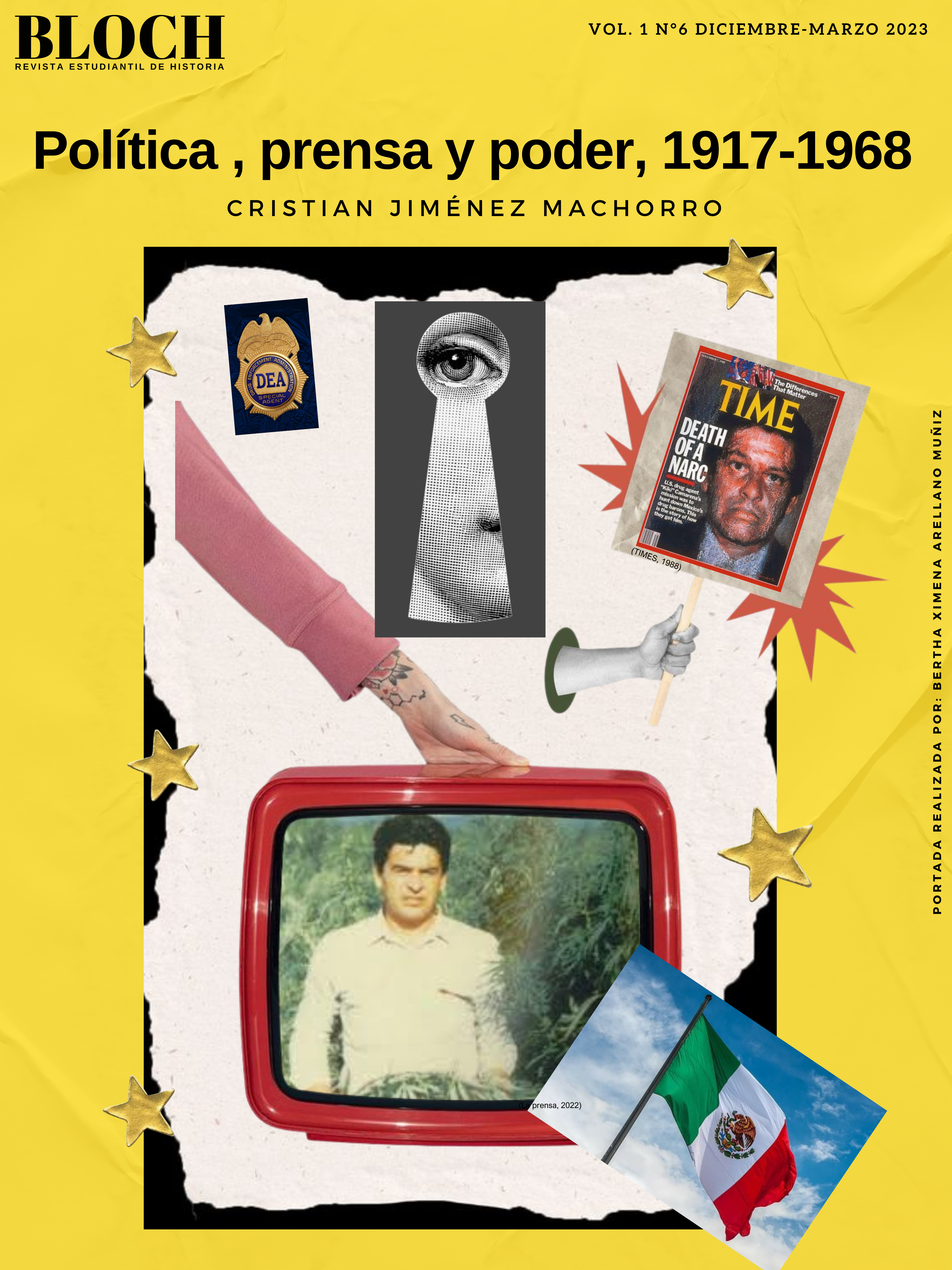
Published 2023-07-20
Keywords
- Press,
- Hegemony,
- Legitimacy,
- Ideological State Device,
- Presidentialism
How to Cite
Copyright (c) 2023 Cristian Jiménez Machorro

This work is licensed under a Creative Commons Attribution 4.0 International License.
Abstract
This research advance is part of the reception work entitled "The Deaths of Camarena, review of the Camarena Case through the Press and its Functioning as the Ideological State Apparatus", which has the objective of analyzing a crisis of hegemony. of the regime of the "Institutional Revolution", which accompanied the crises that occurred during the 1980s (including the economic and political crises). The subsections included in the present advance of the project (subsections I.I and I.II) it is sought to establish the line of historical thought that establishes a precedent, but above all, establish a series of conditions to get to study the period, going through the various conditions that established a hegemonic operation in the country, this being one of the main contributions for the continuation of the investigation: the establishment of a historical explanation for the media crisis that will be addressed.
Downloads
References
- Ariel Rodríguez Kuri, “El presidencialismo en México las posibilidades de una historia”, Historia y política: ideas, procesos y movimientos sociales, 2004. Pp. 131-152. https://dialnet.unirioja.es/servlet/articulo?codigo=897683
- Armando Zacarías, “El papel del papel de PIPSA en los medios mexicanos de comunicación”, Comunicación y sociedad, núm. 25–26 (1996 de 1995): Pp. 73–88.
- Carlos Antonio Aguirre Rojas, “1989 en perspectiva histórica”, en Para comprender el siglo XXI: una gramática de larga duración (Barcelona: El Viejo Topo, 2005).
- Carlos Monsiváis, “Muerte y resurrección del nacionalismo mexicano”, Nexos 109 (1987): Pp. 13–22.
- Carlos Ramírez, Manuel Buendía 1948-1984. Periodismo como compromiso social (Ciudad de México: Centro de estudios políticos y de seguridad nacional, 2014).
- E. J Hobsbawm, Historia del siglo XX: 1914-1991, trad. Faci Juan, Jordi Ainaud, y Carmen Anula Castells (Ciudad de México: Ed. Critica, 2014). P.433.
- Germán Pérez Fernández Del Castillo, “CORPORATIVISMO, DEMOCRACIA Y PODER EN MÉXICO.”, Estudios Políticos 4, núm. 1 (el 3 de enero de 1985): Pp. 5–13.
- Héctor Torres, “La criminalización de la guerrilla urbana en la presencia regiomontana”, Humanitas IV, núm. No.44 (diciembre de 2017): Pp. 129–53. https://humanitas.uanl.mx/index.php/ah/article/view/118
- Jacinto Rodríguez Munguía, “Prensa y poder político en México: Una historia incómoda”, El Cotidiano, núm. 158 (2009): 43–49. https://biblat.unam.mx/hevila/ElCotidiano/2009/no158/8.pdf
- José Ángel Escamilla Rodríguez, “Ocupación militar en Guerrero y la versión de la prensa: Cabañas en la sierra”, en La fuente hemerográfica en la diacronía: verdad de enfoques, ed. María Fernanda García de los Arcos (México: Universidad Autónoma Metropolitana, 2015), Pp. 183-193. https://www.academia.edu/36521323/La_fuente_hemerogr%C3%A1fica_en_la_diacron%C3%ADa
- Lorenzo Meyer, “La crisis del presidencialismo mexicano. Recuperación espectacular y recaída estructural, 1982-1996”, Foro Internacional 36, núm. 1/2 (143/144) (1996): Pp. 20. https://www.jstor.org/stable/27738543
- Lorenzo Meyer, “La prolongada transición mexicana ¿Del autoritarismo hacia dónde?”, Revista de estudios políticos, núm. 74 (diciembre de 1991): P.364. https://dialnet.unirioja.es/descarga/articulo/27128.pdf
- Louis Althusser, Ideología y aparatos ideológicos del estado. Freud y Lacan (Buenos Aires: Ediciones Nueva Visión, 2003) Pp.24-26.
- Soledad Loaeza, “México 1968: Los orígenes de la transición”, Foro internacional 30 (septiembre de 1989): Pp. 66–92. https://www.jstor.org/stable/27755684
